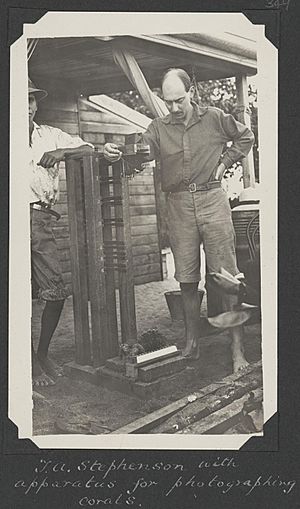Thomas Alan Stephenson facts for kids
Quick facts for kids
Thomas Alan Stephenson
|
|
|---|---|
 |
|
| Born |
Thomas Alan Stephenson
19 January 1898 |
| Died | 3 April 1961 (aged 63) |
| Alma mater | Aberystwyth University |
| Awards | Fellow of the Royal Society |
| Scientific career | |
| Institutions | Aberystwyth University |
| Author abbrev. (botany) | T.A.Stephenson |
| Author abbrev. (zoology) | T.A.Stephenson |
Thomas Alan Stephenson (born January 19, 1898 – died April 3, 1961) was a British naturalist and marine biologist. He was an expert in studying sea anemones, which are amazing sea creatures that look like flowers but are actually animals. He was also a Fellow of the Royal Society, a very important science group.
Contents
Early Life and Family
Thomas Alan Stephenson, who was known by his middle name, Alan, was born on January 19, 1898. His birthplace was Burnham-on-Sea in Surrey, England. He was the oldest of three children. His father, Thomas Stephenson, was a Wesleyan minister and enjoyed studying plants as a hobby. His mother was Margaret Stephenson.
Alan's first six years were spent in Richmond, Surrey. His father worked at Richmond Theological College. These years were described as the happiest part of Alan's childhood. He remembered living in a nice house with big gardens. They were close to Richmond Park and the River Thames.
Moving Around as a Child
In 1904, Alan's father became a traditional Wesleyan minister. This meant the family moved often, usually every three years. They lived in places like Clapham, Wrexham, Timperley, and Aberystwyth. Moving so much was hard for Alan. His schooling was often interrupted, and he found it difficult to make lasting friendships.
Education and Discoveries
Alan Stephenson went to schools in Clapham and Wrexham. While living in Wrexham, he met Harold Drinkwater. Dr. Drinkwater was a doctor and also loved studying plants. He was a very talented painter.
Dr. Drinkwater taught Alan how to paint flowers. He also let Alan join him on his doctor's rounds. This friendship helped Alan learn a lot about plants and even human anatomy. This special friendship lasted throughout Dr. Drinkwater's life. After Wrexham, Alan went to Kingswood School in Bath. He enjoyed long walks in the countryside more than school games.
University Studies
Alan's chance to go to university came when his family moved to Aberystwyth. He started at University College, Aberystwyth in October 1915. His studies were paused for a while because he became ill.
At the university, Alan was helped by H. J. Fleure, a professor who studied animals and geography. Professor Fleure strongly encouraged Alan's interest in sea anemones. He even helped Alan become a student-demonstrator in 1916.
Professor Fleure also gave Alan access to sea anemones collected during the 1910–1913 Terra Nova Expedition to Antarctica. Alan studied these creatures, and his first articles about them were published when he was just 20 years old. In 1920, he earned his Master of Science degree based on his published work.
Working with Orchids
From 1920 to 1923, Alan continued his research at Aberystwyth. He also started working with his father on studies about orchids. They wrote more than 20 papers together between 1920 and 1926.
Their work helped identify a new type of orchid called Dactylorhiza purpurella. They also helped tell the difference between two kinds of Epipactis orchids. In 1923, Alan earned his Doctor of Science degree. He received it based on his published work on both sea anemones and orchids.
Career and Research
Around 1922 or 1923, Alan Stephenson became a lecturer in zoology at University College, London. He kept working on his studies of orchids and sea anemones. In 1928, he published the first of two books called The British Sea Anemones.
That same year, Alan joined the 1928 Great Barrier Reef expedition. He was invited by Maurice Yonge, the leader of the trip. Alan was a great choice because he knew so much about sea anemones. These animals are closely related to the corals found in the Great Barrier Reef.
Alan Stephenson held several teaching jobs in Britain. He also worked at the University of Cape Town in South Africa. His last job was as a professor and head of the Zoology Department at the University College of Wales, Aberystwyth.
Some of his personal notes, paintings, and scientific records are kept at the National Marine Biological Library in Plymouth.
Personal Life
Alan Stephenson married Anne Wood in 1922. Anne was one of two twin sisters. Her father worked for a company that built docks in south Wales. Alan and Anne Stephenson did not have any children.

